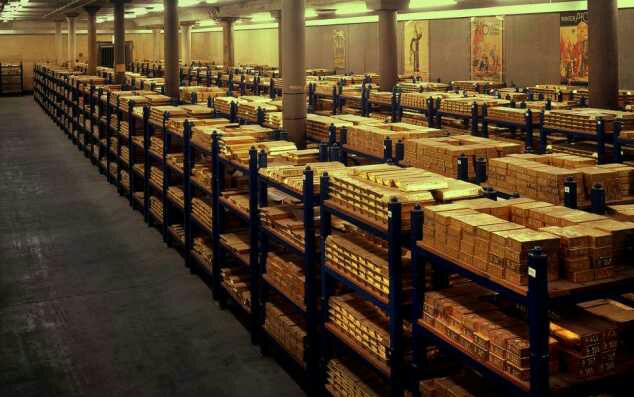Mining is the extraction of valuable minerals or other geological materials from the earth from an orebody, lode, vein, seam, or reef, which forms the mineralized package of economic interest to the miner. Wiki.
Here are some pictures/interesting facts you probably don't know about mining.
1. Oil Fields from Space:
Night views of Earth show the distribution of oil field activity(NASA).
Nigeria is the largest producer of oil in Africa. Much of that production is offshore and in the Niger Delta where exploration, production, processing, and transport facilities are illuminated at night and where natural gas is flared because it lacks a local market or transport options. There are also numerous locations of oil activity offshore of Angola, Congo, and Gabon. This satellite image was compiled by NASA, the annotations, caption, and inset map were produced by Geology.com.
2. Gold and copper were the first metals to be discovered by man around 5,000 BC.
3. Petroleum is used to make over 6,000 items, including; paint, dresses, CD players, antifreeze, lipstick and hair colouring.
4. Most modern electronic devices contain over 35 minerals.
5. If you can’t grow it, it has to be mined or recycled
6. Twenty-Four-Karat Gold is not pure gold since there is a small amount of copper in it. Absolutely pure gold is so soft that it can be molded with the hands.
7. After the gold has been mined approx. 63 percent is used in jewelry, 21 percent as coins, 15per cent in industrial uses including electronics and the other 1 percent in dental.
8. Gold will not oxidize, rust, tarnish, corrode, decay, or deteriorate.
9. The value of a diamond is based upon its carat weight, clarity, color and the quality of its cut. Most diamonds are in a color range that runs from clear to yellow to brown. Colorless receive the highest grade and are generally of highest value.
10. Diamonds are a high-temperature, high- pressure minerals. They do not form naturally at Earth's surface or at shallow depths. The conditions where they can form are in Earth's mantle about 100 miles below the earth's surface.
11. Bucket-wheel Excavators.
* Weight: 45,000 tons.
* Mining speed/Capacity: 4,500 tons Per Hour.
* Operators: 27 Miners/Operators.
* Assembly cost: £66million.
* Saw diameter: 12 meters.
* Height: 45 meters.
* Traveling Speed: One mile every three hours. But once it has reached its destination, it is capable of scooping out 4,500 tons of coal per hour.
* All-weather performance.
12. Total daily oil consumption around the world is 84,249,000 barrels/day.
13. Crude oil is considered the "mother of all commodities "because of its use in the manufacturing of numerous products, including gasoline, synthetic fabrics, plastics, and pharmaceuticals.
14. Texas is the leading state in crude oil production with over 5 billion barrels in reserves.
15. Products like fertilizers, plastics, car tires, ammonia, perfumes, and even bubble gum are synthesized using petroleum products obtained during the crude oil refining process.
16. OPEC countries hold over three-quarters of the world’s proven oil reserves, and that number is rising.
17. The U.S. has over 200,000 miles of oil pipelines within its borders.
18. Saudi Arabia’s Ghawar oil field contains about 85 billion barrels of oil (the world’s largest).
19. Oil is created from the decomposition of organic materials under intense heat and pressure over millions of years.
20. The largest oil spill in history, the Deepwater Horizon oil spill in 2010, spilled 4.2 million barrels of oil into the Gulf of Mexico.
21. According to a major study, about 80% of all oil spills are caused by human error.
22. Saudi Arabia is the largest oil producer today and has the largest amount of reserves (267 billion barrels).
23. The U.S. is the biggest consumer of oil at over 19.5 million barrels a day.
24. Thanks to large amounts of oil reserves and government subsidies, as of December 2010, the average price of gas in Caracas, Venezuela is 12 cents per U.S. gallon.
25. Diesel fuel produced about 11% more energy than an equal volume of gasoline and actually produces slightly less carbon dioxide emissions.
26. Oil rigs are necessary tools in the exploration, extraction and refinement of oil deposits both on land and at sea. If you live in a coastal city, particularly a city that contains oil refineries, you may be able to see oil rigs from the shore of your local beach. Oil rigs are interesting for their intricate processes, regulations and sheer numbers globally.
27. Portability: Oil rigs, unlike their predecessors from the early days of oil drilling, are quite portable, and can be transported from one drilling site to the next. The tall derrick located on the oil rigs contains the drilling pipe and bits necessary to pierce the bedrock in search of oil. When the oil rig has pumped all of the available oil from the location, the well is sealed and the pipe equipment is hauled back onto the rig. A large ship or tug boat(s) then tow the rig to its next destination.
28. Gold melts at 1064.43° Centigrade. It can conduct both heat and electricity and it never rusts even when buried for a thousand years.
29. The world’s largest stockpile of gold can be found five stories underground inside the Federal Reserve Bank of New York’s vault and it holds 25% of the world's gold reserve (540,000 gold bars). While it contains more gold than Fort Knox, most of it belongs to foreign governments.
The Bank of England's vault under central London contains 4,600 tons of the precious metal, worth an incredible £156billion.
The rows of simple shelves are stacked high with 28lb 24-carat gold bars.
30. Mining is one of the most dangerous and deadliest jobs on earth.
Mining kills and injures more workers than any other industry. For example
* The USA: From January to October 1999, 45mine workers died because of workplace accidents.
* South Africa: One worker dies and 12 are seriously injured for every ton of gold produced.
* China: 3,362 people died as a result of accidents in coal mines in 1996.
* Worldwide: Uranium mining has caused 20,000 deaths since the 1950s. Uranium mining has exposed more workers to radiation than any other industry.
31. The deep-sea is the largest museum on Earth: There are more artifacts and remnants of history in the ocean than in all of the world’s museums, combined.
32. We have only explored less than 5 percent of the Earth’s oceans. In fact, we have better maps of Mars than we do of the ocean floor
Here are some pictures/interesting facts you probably don't know about mining.
1. Oil Fields from Space:
Night views of Earth show the distribution of oil field activity(NASA).
Nigeria is the largest producer of oil in Africa. Much of that production is offshore and in the Niger Delta where exploration, production, processing, and transport facilities are illuminated at night and where natural gas is flared because it lacks a local market or transport options. There are also numerous locations of oil activity offshore of Angola, Congo, and Gabon. This satellite image was compiled by NASA, the annotations, caption, and inset map were produced by Geology.com.
2. Gold and copper were the first metals to be discovered by man around 5,000 BC.
3. Petroleum is used to make over 6,000 items, including; paint, dresses, CD players, antifreeze, lipstick and hair colouring.
4. Most modern electronic devices contain over 35 minerals.
5. If you can’t grow it, it has to be mined or recycled
6. Twenty-Four-Karat Gold is not pure gold since there is a small amount of copper in it. Absolutely pure gold is so soft that it can be molded with the hands.
7. After the gold has been mined approx. 63 percent is used in jewelry, 21 percent as coins, 15per cent in industrial uses including electronics and the other 1 percent in dental.
8. Gold will not oxidize, rust, tarnish, corrode, decay, or deteriorate.
9. The value of a diamond is based upon its carat weight, clarity, color and the quality of its cut. Most diamonds are in a color range that runs from clear to yellow to brown. Colorless receive the highest grade and are generally of highest value.
10. Diamonds are a high-temperature, high- pressure minerals. They do not form naturally at Earth's surface or at shallow depths. The conditions where they can form are in Earth's mantle about 100 miles below the earth's surface.
11. Bucket-wheel Excavators.
* Weight: 45,000 tons.
* Mining speed/Capacity: 4,500 tons Per Hour.
* Operators: 27 Miners/Operators.
* Assembly cost: £66million.
* Saw diameter: 12 meters.
* Height: 45 meters.
* Traveling Speed: One mile every three hours. But once it has reached its destination, it is capable of scooping out 4,500 tons of coal per hour.
* All-weather performance.
12. Total daily oil consumption around the world is 84,249,000 barrels/day.
13. Crude oil is considered the "mother of all commodities "because of its use in the manufacturing of numerous products, including gasoline, synthetic fabrics, plastics, and pharmaceuticals.
14. Texas is the leading state in crude oil production with over 5 billion barrels in reserves.
15. Products like fertilizers, plastics, car tires, ammonia, perfumes, and even bubble gum are synthesized using petroleum products obtained during the crude oil refining process.
16. OPEC countries hold over three-quarters of the world’s proven oil reserves, and that number is rising.
17. The U.S. has over 200,000 miles of oil pipelines within its borders.
18. Saudi Arabia’s Ghawar oil field contains about 85 billion barrels of oil (the world’s largest).
19. Oil is created from the decomposition of organic materials under intense heat and pressure over millions of years.
20. The largest oil spill in history, the Deepwater Horizon oil spill in 2010, spilled 4.2 million barrels of oil into the Gulf of Mexico.
21. According to a major study, about 80% of all oil spills are caused by human error.
22. Saudi Arabia is the largest oil producer today and has the largest amount of reserves (267 billion barrels).
23. The U.S. is the biggest consumer of oil at over 19.5 million barrels a day.
24. Thanks to large amounts of oil reserves and government subsidies, as of December 2010, the average price of gas in Caracas, Venezuela is 12 cents per U.S. gallon.
25. Diesel fuel produced about 11% more energy than an equal volume of gasoline and actually produces slightly less carbon dioxide emissions.
26. Oil rigs are necessary tools in the exploration, extraction and refinement of oil deposits both on land and at sea. If you live in a coastal city, particularly a city that contains oil refineries, you may be able to see oil rigs from the shore of your local beach. Oil rigs are interesting for their intricate processes, regulations and sheer numbers globally.
27. Portability: Oil rigs, unlike their predecessors from the early days of oil drilling, are quite portable, and can be transported from one drilling site to the next. The tall derrick located on the oil rigs contains the drilling pipe and bits necessary to pierce the bedrock in search of oil. When the oil rig has pumped all of the available oil from the location, the well is sealed and the pipe equipment is hauled back onto the rig. A large ship or tug boat(s) then tow the rig to its next destination.
28. Gold melts at 1064.43° Centigrade. It can conduct both heat and electricity and it never rusts even when buried for a thousand years.
29. The world’s largest stockpile of gold can be found five stories underground inside the Federal Reserve Bank of New York’s vault and it holds 25% of the world's gold reserve (540,000 gold bars). While it contains more gold than Fort Knox, most of it belongs to foreign governments.
The Bank of England's vault under central London contains 4,600 tons of the precious metal, worth an incredible £156billion.
The rows of simple shelves are stacked high with 28lb 24-carat gold bars.
30. Mining is one of the most dangerous and deadliest jobs on earth.
Mining kills and injures more workers than any other industry. For example
* The USA: From January to October 1999, 45mine workers died because of workplace accidents.
* South Africa: One worker dies and 12 are seriously injured for every ton of gold produced.
* China: 3,362 people died as a result of accidents in coal mines in 1996.
* Worldwide: Uranium mining has caused 20,000 deaths since the 1950s. Uranium mining has exposed more workers to radiation than any other industry.
- 10 billion tons of gold sits underneath the sea bed, it is destined to sit here however as there is no way to access it.
- About 70 percent of the planet is ocean, with an average depth of more than 12,400 feet. Given that photons (light) can’t penetrate more than 330 feet below the water’s surface, most of our planet is in a perpetual state of darkness.
31. The deep-sea is the largest museum on Earth: There are more artifacts and remnants of history in the ocean than in all of the world’s museums, combined.
32. We have only explored less than 5 percent of the Earth’s oceans. In fact, we have better maps of Mars than we do of the ocean floor


























Trending